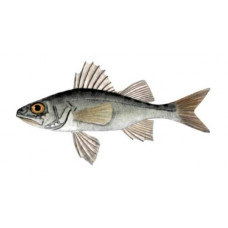Latin name
Percarina demidoffii
Other names
Percarina demidoffii
Identification
Externally the fish resembles Gymnocephalus. Life expectancy is 3-4 years. The body is elongated, rather tall, compressed at the sides, covered with thin scales that fall off easily when touched. The base of the pectoral fins is above the base of the pelvic fins. The lateral line is complete. The mouth is large, with small teeth. On the sides of the head are large mucous separating cavities, the body is covered with a layer of mucus. The head, including the gill covers, and the thorax are not covered with scales. The diameter of the eye is equal to the length of the snout. When alive, the body is almost transparent, the upper part of the head and back yellowish-milky, the belly greyish-silvery white. There are often dark spots along the lateral line, up to 8-9 dark rounded spots along the base of the dorsal fins, and a brownish crescent-shaped spot on one part of the head. The fins are translucent with yellowing.
Distribution
Occurs in the Sea of Azov, in the north-west of the Black Sea basin in estuaries and coastal lakes, and in the lower reaches of rivers flowing into this part of the Black Sea.
Habitat
Its biology is poorly understood. It is a saltwater, gregarious, benthic-pelagic fish, usually confined to estuaries, sometimes found in estuaries and river mouths, sometimes forming freshwater populations. Occurs at depths of up to 5 metres, usually in places with sandy-silt, muddy or silty shell substrate, often noted and in the water column. Forms large aggregations, sometimes with tulka or other fish.
Size
Maximum length and weight 11 cm and 11 g, usually up to 8 cm and 6 g.
Life history and Behavior
In spring, some fish migrate to river mouths to spawn.
Food and feeding habits
Depending on the season, it feeds on detritus, algae and other vegetation, plankton, bottom dwellers - worms, crustaceans, molluscs, larvae, adult insects, etc., as well as eggs and young fish (tulka, atherina, gobies, etc.). It is a carnivorous species.
Reproduction
Breeding begins in the second year of life. The eggs are sticky, but do not stick to the bottom as they are quickly covered with a layer of adhering small particles of silt, making it easier to camouflage the eggs from small predators. The reproductive capacity of this species is high, with a minimum doubling time of about 15 months. The hatched larvae initially lie on the bottom, then begin to occasionally float to the surface and in two days become pelagic. Juveniles feed on small invertebrates, then almost exclusively on the crustaceans Calanipedes and Mysids, and when they reach 4cm in length - on juvenile gobies and tulka.
| Classification | |
| Phylum | Chordata |
| Class | Actinopterygii |
| Squad | Perciformes |
| Family | Percidae |
| Genus | Percarina |
| Species | P. demidoffii |
| Features | |
| Conservation status | Near Threatened |
| Habitat | Pelagic |
| Life span, years | 4 |
| Maximum body weight, kg | 0,011 |
| Maximum length, cm | 11 |
| Sailing speed, m/s | No information |
| Threat to people | Inedible |
| Way of eating | Predator |
Common percarina
Tags: common percarina

